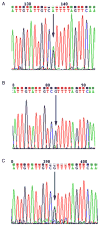No evidence that protein truncating variants in BRIP1 are associated with breast cancer risk: implications for gene panel testing
- PMID: 26921362
- PMCID: PMC4938802
- DOI: 10.1136/jmedgenet-2015-103529
No evidence that protein truncating variants in BRIP1 are associated with breast cancer risk: implications for gene panel testing
Abstract
Background: BRCA1 interacting protein C-terminal helicase 1 (BRIP1) is one of the Fanconi Anaemia Complementation (FANC) group family of DNA repair proteins. Biallelic mutations in BRIP1 are responsible for FANC group J, and previous studies have also suggested that rare protein truncating variants in BRIP1 are associated with an increased risk of breast cancer. These studies have led to inclusion of BRIP1 on targeted sequencing panels for breast cancer risk prediction.
Methods: We evaluated a truncating variant, p.Arg798Ter (rs137852986), and 10 missense variants of BRIP1, in 48 144 cases and 43 607 controls of European origin, drawn from 41 studies participating in the Breast Cancer Association Consortium (BCAC). Additionally, we sequenced the coding regions of BRIP1 in 13 213 cases and 5242 controls from the UK, 1313 cases and 1123 controls from three population-based studies as part of the Breast Cancer Family Registry, and 1853 familial cases and 2001 controls from Australia.
Results: The rare truncating allele of rs137852986 was observed in 23 cases and 18 controls in Europeans in BCAC (OR 1.09, 95% CI 0.58 to 2.03, p=0.79). Truncating variants were found in the sequencing studies in 34 cases (0.21%) and 19 controls (0.23%) (combined OR 0.90, 95% CI 0.48 to 1.70, p=0.75).
Conclusions: These results suggest that truncating variants in BRIP1, and in particular p.Arg798Ter, are not associated with a substantial increase in breast cancer risk. Such observations have important implications for the reporting of results from breast cancer screening panels.
Keywords: Cancer: breast.
Published by the BMJ Publishing Group Limited. For permission to use (where not already granted under a licence) please go to http://www.bmj.com/company/products-services/rights-and-licensing/
Conflict of interest statement
GM reports grants from Cancer Australia during the conduct of the study; personal fees from AstraZeneca outside the submitted work. AS reports grants from Breast Cancer Now (previously Breakthrough Breast Cancer) during the conduct of the study. SVT reports grants from US National Cancer Institute during the conduct of the study and is an inventor on most of the key BRCA1 and BRCA2 patents. The claims in these patents that constrained commercial genetic testing by entities other than Myriad Genetics have been overturned, expired or abandoned. MWB reports grants from ELAN Found during the conduct of the study. DEG has US Patent nos. 5747282; 5710001; 5837942; 6033857 with royalties paid by Myriad Genetics. CV reports grants from NCI during the conduct of the study. PAF reports grants and/or personal fees from Amgen, Novartis, Biomarin, Roche, Pfizer, GSK, TEVA and Genomic Health, outside the submitted work. RNL reports grants from Medical Research Council and Cancer Research UK during the conduct of the study.
Figures


Comment in
-
Risky business: getting a grip on BRIP.J Med Genet. 2016 May;53(5):296-7. doi: 10.1136/jmedgenet-2015-103648. Epub 2016 Feb 26. J Med Genet. 2016. PMID: 26921361 No abstract available.
References
-
- Ghoussaini M, Pharoah PD, Easton DF. Inherited genetic susceptibility to breast cancer: the beginning of the end or the end of the beginning? AmJPathol. 2013;183:1038–51. - PubMed
-
- Easton DF, Pharoah PD, Antoniou AC, Tischkowitz M, Tavtigian SV, Nathanson KL, Devilee P, Meindl A, Couch FJ, Southey M, Goldgar DE, Evans DG, Chenevix-Trench G, Rahman N, Robson M, Domchek SM, Foulkes WD. Gene-panel sequencing and the prediction of breast-cancer risk. N Engl J Med. 2015;372:2243–57. - PMC - PubMed
-
- Cantor SB, Bell DW, Ganesan S, Kass EM, Drapkin R, Grossman S, Wahrer DC, Sgroi DC, Lane WS, Haber DA, Livingston DM. BACH1, a novel helicase-like protein, interacts directly with BRCA1 and contributes to its DNA repair function. Cell. 2001;105:149–60. - PubMed
-
- Litman R, Peng M, Jin Z, Zhang F, Zhang J, Powell S, Andreassen PR, Cantor SB. BACH1 is critical for homologous recombination and appears to be the Fanconi anemia gene product FANCJ. Cancer cell. 2005;8:255–65. - PubMed
-
- Levitus M, Waisfisz Q, Godthelp BC, de Vries Y, Hussain S, Wiegant WW, Elghalbzouri-Maghrani E, Steltenpool J, Rooimans MA, Pals G, Arwert F, Mathew CG, Zdzienicka MZ, Hiom K, De Winter JP, Joenje H. The DNA helicase BRIP1 is defective in Fanconi anemia complementation group J. Nat Genet. 2005;37:934–5. - PubMed
MeSH terms
Substances
Grants and funding
- R01 CA176785/CA/NCI NIH HHS/United States
- UM1 CA164920/CA/NCI NIH HHS/United States
- R01 CA121245/CA/NCI NIH HHS/United States
- R01 CA092447/CA/NCI NIH HHS/United States
- R01 CA100374/CA/NCI NIH HHS/United States
- U01 CA116167/CA/NCI NIH HHS/United States
- R01 CA128978/CA/NCI NIH HHS/United States
- R01 CA064277/CA/NCI NIH HHS/United States
- P50 CA116201/CA/NCI NIH HHS/United States
- R01 CA063464/CA/NCI NIH HHS/United States
- U19 CA148112/CA/NCI NIH HHS/United States
- P30 CA042014/CA/NCI NIH HHS/United States
- R37 CA070867/CA/NCI NIH HHS/United States
- 16565/CRUK_/Cancer Research UK/United Kingdom
- U19 CA148537/CA/NCI NIH HHS/United States
- R01 CA116167/CA/NCI NIH HHS/United States
- R01 CA148667/CA/NCI NIH HHS/United States
- U01 CA063464/CA/NCI NIH HHS/United States
- R01 CA077398/CA/NCI NIH HHS/United States
- R01 CA054281/CA/NCI NIH HHS/United States
- R01 CA132839/CA/NCI NIH HHS/United States
- P30 CA068485/CA/NCI NIH HHS/United States
- U01 CA098758/CA/NCI NIH HHS/United States
- N01 CN025403/CA/NCI NIH HHS/United States
- U19 CA148065/CA/NCI NIH HHS/United States
- 10119/CRUK_/Cancer Research UK/United Kingdom
- WT_/Wellcome Trust/United Kingdom
- UM1 CA182910/CA/NCI NIH HHS/United States
- 10118/CRUK_/Cancer Research UK/United Kingdom
- R01 CA192393/CA/NCI NIH HHS/United States
- 001/WHO_/World Health Organization/International
- U01 CA164973/CA/NCI NIH HHS/United States
- R37 CA054281/CA/NCI NIH HHS/United States
- 16561/CRUK_/Cancer Research UK/United Kingdom
- 10124/CRUK_/Cancer Research UK/United Kingdom
LinkOut - more resources
Full Text Sources
Other Literature Sources
Medical
Molecular Biology Databases
Research Materials
Miscellaneous
